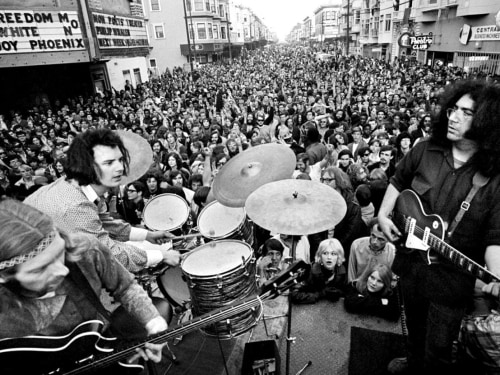

The Grateful Dead changed their name from the Warlocks in December 1965 and the rest was history.
From a psychedelic poster perspective, it is interesting to note that the Dead were not the top San Francisco group through the late 1960s - that mantle belonged to the Jefferson Airplane with several top 10 hits to their credit, and when the two bands were billed together on the same poster, the Airplane were the headliners. It wasn't until the creative explosion of albums by the Dead and their indivudual members from 1970-1972 and the implosion of the Airplane that the Grateful Dead became the spokesband for the San Francisco experience.
The Dead, like most of the SF-bands, were not too picky about playing the Fillmore versus the Avalon and they all played multiple shows and many many venues - leaving us a nice batch of work by the psychedelic poster artists. Of the Big Five poster artists, it was Stanley Mouse (often with Alton Kelley) whose work followed the Dead through the years. While Rick Griffin contributed the art for Aoxomoxoa (originally a concert poster), Mouse and Kelley introduced the iconic Skeleton and Roses motif in the highly coveted October 1966 poster of the same name, known to collectors everywhere as just "FD-26."
According to poster expert Eric King, the Grateful Dead were without a logo and the SF poster artists had been trying to supply that inspiration to the band in 1966 when they had a chance to highlight them in a poster. The first attempt was Wes Wilson’s, “The Quick and The Dead” poster from June of 1966 featuring a Jose Posada image of a dapper skeleton with a bow tie and hat. In August 1966, Stanley Mouse and Alton Kelley got their chance and created a poster featuring a quite stoned-looking Frankenstein monster. Evidently Mouse and Kelley were as toasted as their image because they spelled the name of the band wrong ("Greatful"). This image did not capture the affection of the band but the third time was the charm as the poster Mouse and Kelley designed for the Dead in September 1966 featured the well-known skeleton and roses image that became forever linked to the Grateful Dead.
Grateful Dead posters are highly coveted by collectors and Deadheads alike, so many of the most iconic among them can be fairly expensive. They are also, however, most likely to go up in value as they aren't making any more of them. The Skeleton and Roses first printing sold at auction in 2018 twice for more than $50,000 and in November 2019 a minty pristine original sold for $118,750, the high water mark for mainstrean psychedleic poster art. That said, there are still many fine works available for much much less than that.
